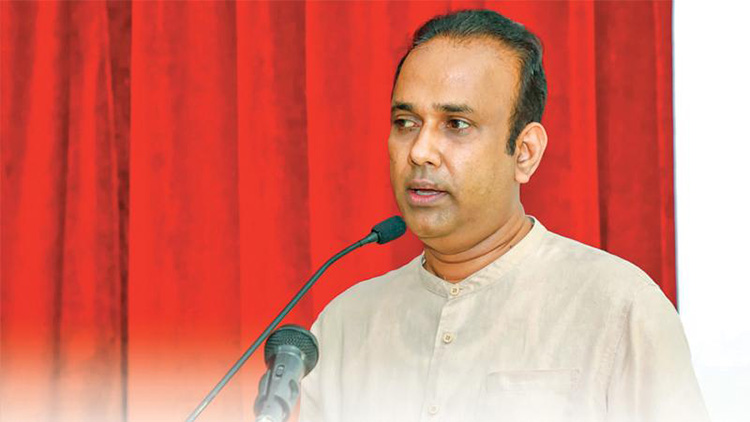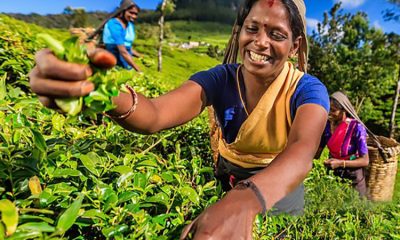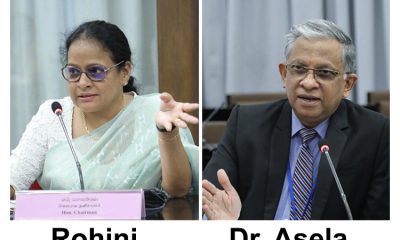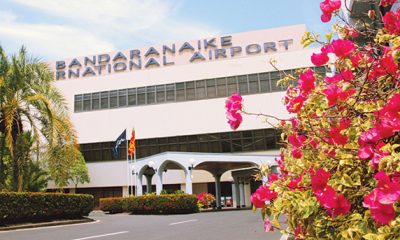Features
Joining in Psychosocial work back home in Sri Lanka

(Excerpted from Memories that linger…..My journey in the world of disability by Padmani Mendis)
When my memories come back to Sri Lanka they call out urgently, “Remember first the Psychosocial Project!” For the PSP was unique. It was implemented during the long conflict for our people affected by it in the northern and eastern parts of our country. Led by Gameela Samarasinghe and Ananda Galapatti with Harini Amarasuriya, Kusala Wettasinghe and others.
Later, but still also during the conflict, with some of these and other committed psychosocial workers memories of meeting needs this time of our “Ranaviru” or disabled soldiers. This was with the Ranaviru Seva Authority, RVSA, under the chairmanship of Dr. Narme Wickramasinghe with the able assistance of Dr. Visakha Dissanayake. The RVSA worked in the areas where our armed forces came from.
Within both the PSP and the RVSA I had the privilege of being invited to work with our psychosocial workers to see to the disability needs of civilians in the first project and of members of our armed forces in the second with whom they interacted. Those were difficult times for our people, but as always, our young professionals stepped forward to serve their fellow country women and men.
Introducing Community-based Rehabilitation to the NGO Sector in Sri Lanka
To continue with memories of my journey, I have to go back now to the year 1979 and the month of August, when I returned home after my first assignment for the WHO in Geneva. Whilst I was carrying out my task participating with so many others in the global development of the concept, strategy and technology of CBR (Community Based Rehabilitation), my thoughts were constantly of how these would fit so well in Sri Lanka to benefit our disabled people.
So, no sooner I returned to Colombo, I made an appointment to meet the Deputy Leader of the NGO Sarvodaya, which in Sri Lanka has been the most well-known NGO in community development. The work of Sarvodaya was based on social mobilisation, just as CBR is. I had come to know Mrs. Sita Rajasooriya when she was a Commissioner in the Girl Guide Movement and I was a teenage girl guide.
Over a chat about what I had been doing in Geneva, I gave her a copy of the WHO Manual and asked her whether she would look at it. She called me a year or so later to tell me that Sarvodaya was implementing a CBR Project in the district of Kalutara in the Western province. I have been there and elsewhere with Sarvodaya several times, visiting with them their people in their homes.
Over the next several years, other NGOs called on me to help them start implementing CBR in many parts of Sri Lanka – Fridsro in Kandy in the Central province, Navajeevana in Tangalle in the Southern province and SEED (Social, Economic and Educational Developers) in Vavuniya in the Northern province were some of the larger ones. All the projects had funding partnerships with outside donors. With evidence of visible and measurable impact, projects grew. In the long-term however potential growth was sometimes stunted by limited funding.
I shall come back to Fridsro later and its relationship with Government CBR programmes under the leadership of Gihan Galekotuwa. Fridsro sans Gihan Galekotuwa has now had to fade out of the realm of disability due to unavailability of sponsorship.
Sarvodaya, Navajeevana and SEED led respectively by Dr. A.T. Ariyaratne, and later his son Vinya, the late Kumarini Wikramasuriya and Ponnambalam Narasingham, together with many other NGOs continue their work in disability promoting CBR. The last of the three named above gave his formal name reluctantly when I asked him just now on the telephone, emphasising that he preferred being called “Singham”. This is what I had always known him by.
Time spent with these organisations so long ago are among my most memorable. With SEED it was focused on teaching their staff. SEED had been within sight of the conflict. We used for teaching the top floor of their three-storey building with a roof made of green metal sheets. Made the room very, very warm. But the breeze that wafted through its open sides compensated somewhat.
Here we had some of the most participatory of my teaching sessions in Sri Lanka. SEED staff were active, interested, motivated. Both the heat generated in the atmosphere and that in debate called for frequent ice breakers. These were innovative and enjoyable. But mostly I sat out, needing for myself a mental and physical break from all that dynamism around me.
The only hotel in Vavuniya was filled to capacity with families from the North fleeing the conflict. I stayed there only once. Having to jump over a smelly open sewer made so by disrepair to get into the hotel was off-putting. The disrepair extended to the inside of the hotel because such was the time. Compensating for this the management was concerned and kind, and had found for me a small room with many stairs to climb to get to it. I had all my meals here in my room because there was no other place for it. It was simply furnished with a bed, desk and chair.
There was no kitchen either and the hotel bought me my food from outside. An upset tummy on a few occasions indicated to me that I should find other lodgings next time. So on my following visits, SEED found for me a convent to stay at. Here, living with nuns, I felt cherished. I was their first paying guest. They were truly beautiful with their warmth and their empathy.
Other Experiences with NGOs
Many years later, and still during the long conflict, I was back North again twice on my journey. The first time I was in Jaffna. It was with Save the Children Fund (SCF), UK. They sent me so I could advise them how they could include actions for disabled children within their Northern programme.
Much of Jaffna district at the time was under the control of the Tamil Tigers. SCF had to obtain special permission for me to come to Jaffna, which, it turned out, they did quite easily. I believe it was easy because someone had got my name wrong. On the letter granting permission it was written “Pathmini”, the way it is in Tamil. I was given permission to travel anywhere I needed. I was not even stopped at checkpoints. Everywhere I went, it seemed as though I was expected.
The next work assignment in the North at this time included coming back to Vavuniya. I was here with Hameed of UNICEF as part of a series of teaching assignments I did to introduce to district and divisional officials issues related to disability in children. And to discuss with them how they may deal with such issues during the course of their work, so attempting to include childhood disability in development strategies during this time of conflict.
The series also covered Puttalam, Mannar and Trincomalee, stretching out across our island. As far as I know, those workshops were never followed up. I hope the seed had been planted in many an interested mind and would have taken root in some. It was a difficult time for all.
Before my memories of the NGO sector move on, there is another that asks for recall. Save the Children Fund, UK showed much concern for disabled children, making their work inclusive to the extent possible. With that in mind, they had me develop for them in partnership with teachers, parents, children and others, “A Guide for Preschool Teachers”. SCF had it published in all three languages and it was widely used, especially in CBR. It helped bring into the preschool mainstream many young children at an early age. This was a task that gave me much satisfaction.
This was soon after the Tsunami of 2006. Looking back, it is clear that activities of the International NGOs at this time was at a peak. Sri Lanka was the beneficiary of generous help from a caring world.
How CBR came to be in government
Dudley Dissanayake was the Director of the School of Social Work managed by the Department of Social Services. This was located on Bagatalle Road in a two-storied house. Rent was paid for by Government. One day I received a call from Dudley asking if we could meet. We met the next day. He told me about the reason for his call.
He said that quite recently he had found in the back seat of the pick-up truck that he drove, a photocopy of a book. He did not know how it had got there, but his staff shared the use of the pick-up truck. They used this also to transport students for official tasks.
The book had been made by WHO and was about disabled people. It had my name on the cover along with two others. Dudley wanted to know what it was about. I was of course only too happy to share with him the work I was doing in Geneva with my colleagues Gunnel Nelson and Einar Helander and with innumerable others spread throughout many countries.
This was now 1981 which the UN had declared as the “International Year of the Disabled”. It was customary for the UN to do such things on subjects that they felt required the attention of member states. To mark its significance, Dudley felt that students of social work should have an exposure with disabled people and disability. We discussed how this could be done.
The result was that two students expressed their wish to carry out their final year project study testing the usefulness of the Manual in Sri Lanka. Dudley asked me if I could help them, and I believe I was fortunate to be able to do so. I said that first I would have the Manual translated into Sinhala.
For this purpose, I obtained the willing help of two physiotherapists, formerly favourite students. By name Wettimuny Silva and Somadasa Mohettige. While they did the translation in their own homes in the evenings after work, we met at my dining table in my home in Swarna Road for joint sessions which, as you can imagine, were called for quite often. We had the Sinhala Manual ready in no time. Wetta and Some, as their friends called them, and I maintain the bond we established at that time and continue our friendship.
First Field Tests in Sri Lanka
Dudley had the necessary photocopies made. I was soon walking the two villages of Meegolla and Kahandawelipotha in the Kurunegala district with the two students of social work. They had selected between them 20 children who had disability all under the age of 14 years. At the end of the six months of the project, 19 of the 20 showed improvements. Some of those children still live vividly in my memory.
One was Mala, aged eight years, who had cerebral palsy. Her mother cared for her with utmost love. She bathed, dressed and fed Mala in the morning and sat her on a chair at a window. Mala spent her day watching passers-by on the road.
That was until the two students of social work came into their lives. Soon Mala was learning to walk using bars her father made in the garden using long bamboos. She was helping her mother in the kitchen. Children from the neighbourhood came to her house to play with her. Hopefully in a few months she would go to the village school. The students arranged for the local social service worker to come to see Mala. The social service worker will get a wheelchair for Mala.
Another was 11-year-old Nandani. She too did not go to school. Her parents could not see how she could do that, seeing she could not speak. But she could hear. Like Ntchadi in faraway Serowe in Botswana, she too looked on longingly when her young siblings went to school. Counselling from the students, an appointment with the principal and the education officer and Nandani was in school.
When we visited the school before the project ended, Nandani was already showing signs of leadership in the classroom. She was a bright girl. She will surely catch up with her peers before long.
Dudley shared with UNICEF Colombo the study and the results of the work of the students. He was able to secure from UNICEF formal support for the development of CBR as project studies for a number of his students over the next few years. But within three years UNICEF, with the Department of Social Work and the help of students, started a large CBR project in Anuradhapura district.
In time Dudley, climbing the administrative ladder step by step reached the Ministry of Social Welfare. It was first as Senior Assistant Secretary, then as Additional Secretary, and finally reached the peak as Secretary of the Ministry. Dudley took CBR there with him. Dudley had the Manual translated into Tamil and introduced its extended use in the North. From then on CBR grew within Government with generous allocations directly from the national budget.
Disability Studies Unit – Early Years in Sri Lanka
I shared with you in the section above how the University of Kelaniya, in 1993 with support from Sweden, set up the Disability Studies Unit or DSU and of my role in it. I also continued in that section to share with you my journey in disability during my time there, focusing on aspects of international work. This is a suitable time perhaps to reflect on my journey with the DSU in Sri Lanka.
It was Anoja Wijeyesekera, at the time a Programme Officer at UNICEF Colombo who introduced the DSU to the Ministry of Social Welfare. Viji Jegarasasingham was the Additional Secretary at the time. Mrs. J. was one dynamic lady with a mission. That mission was to ensure the effective functioning of her ministry and other institutions under her purview. She was later promoted as Secretary and held that post for many years until her retirement from Government service.
Viji Jegarajasingham, our Mrs J., set up within the Ministry a Resource Group on CBR with just five of us as members. One of them was Gihan Galekotuwa or Gale who was then the Disability Programme Head at the NGO Fridsro. Our Resource Group strengthened the relationship in disability work between this ministry and that of health and of employment. This was with the aim of planting the seed of multi-sectoral cooperation to benefit disabled people with a wider perspective of their rights.
Gale was convinced that CBR was the way to go if the rights of disabled children and adults were to be fulfilled with their inclusion and participation in their communities and in society at large. Fridsro had developed their CBR capacity by implementing CBR themselves in parts of the Central Province where they were located. Starting in Poojapitya Division and spreading to 11 others in the Kandy district. These were developed as learning and teaching areas.
Gale soon had Fridsro draw up an MOU with the Ministry of Social Welfare to provide technical and other support to the Ministry to improve their CBR programme both in quality and in coverage. This agreement and action continued for many years, even after I was no longer at the DSU.
Within a few years many disabled children and adults spread out in most of Sri Lanka’s districts had been reached. A change was being brought about in their lives, families and communities. Monitored continuously and evaluated at intervals by Fridsro.
Working with me at the DSU was Somadasa Kodikara, a former student of mine at the School of Physiotherapy. Representing the DSU “Kodi” and I worked with the Ministry and with Fridsro as a threesome to reach disabled people in more than 50% of Sri Lanka’s districts during those few years. The DSU had roles in both teaching and in monitoring. We soon learned that Sri Lanka government workers were loath to submit written reports. As for us, we were happy monitoring through field visits. For us it was any excuse to go to the people.
During our years together at the DSU, Kodi and I continued to evaluate the WHO Manual in the two languages with periodic revisions and continuous improvement. Fridsro provided financial support for publishing them in both languages for field use. Kodi and I also produced and published through the DSU much teaching-learning material for both community workers and for their divisional and district supervisors.
Soon after the DSU was born, we were invited to link up with the Global Disability Database maintained jointly by Uppsala University and AHRTAG in London. Before I left the DSU in 1998, we had an agreement drawn up with the International Health Unit of London University and the Hospital for Children, Great Ormond Street to start the Education of Speech and Language Therapists or SLTs.
. The DSU has come a long way. And it will continue its own journey as it grows unendingly.
Features
The heart-friendly health minister

by Dr Gotabhya Ranasinghe
Senior Consultant Cardiologist
National Hospital Sri Lanka
When we sought a meeting with Hon Dr. Ramesh Pathirana, Minister of Health, he graciously cleared his busy schedule to accommodate us. Renowned for his attentive listening and deep understanding, Minister Pathirana is dedicated to advancing the health sector. His openness and transparency exemplify the qualities of an exemplary politician and minister.
Dr. Palitha Mahipala, the current Health Secretary, demonstrates both commendable enthusiasm and unwavering support. This combination of attributes makes him a highly compatible colleague for the esteemed Minister of Health.
Our discussion centered on a project that has been in the works for the past 30 years, one that no other minister had managed to advance.
Minister Pathirana, however, recognized the project’s significance and its potential to revolutionize care for heart patients.
The project involves the construction of a state-of-the-art facility at the premises of the National Hospital Colombo. The project’s location within the premises of the National Hospital underscores its importance and relevance to the healthcare infrastructure of the nation.
This facility will include a cardiology building and a tertiary care center, equipped with the latest technology to handle and treat all types of heart-related conditions and surgeries.
Securing funding was a major milestone for this initiative. Minister Pathirana successfully obtained approval for a $40 billion loan from the Asian Development Bank. With the funding in place, the foundation stone is scheduled to be laid in September this year, and construction will begin in January 2025.
This project guarantees a consistent and uninterrupted supply of stents and related medications for heart patients. As a result, patients will have timely access to essential medical supplies during their treatment and recovery. By securing these critical resources, the project aims to enhance patient outcomes, minimize treatment delays, and maintain the highest standards of cardiac care.
Upon its fruition, this monumental building will serve as a beacon of hope and healing, symbolizing the unwavering dedication to improving patient outcomes and fostering a healthier society.We anticipate a future marked by significant progress and positive outcomes in Sri Lanka’s cardiovascular treatment landscape within the foreseeable timeframe.
Features
A LOVING TRIBUTE TO JESUIT FR. ALOYSIUS PIERIS ON HIS 90th BIRTHDAY

by Fr. Emmanuel Fernando, OMI
Jesuit Fr. Aloysius Pieris (affectionately called Fr. Aloy) celebrated his 90th birthday on April 9, 2024 and I, as the editor of our Oblate Journal, THE MISSIONARY OBLATE had gone to press by that time. Immediately I decided to publish an article, appreciating the untiring selfless services he continues to offer for inter-Faith dialogue, the renewal of the Catholic Church, his concern for the poor and the suffering Sri Lankan masses and to me, the present writer.
It was in 1988, when I was appointed Director of the Oblate Scholastics at Ampitiya by the then Oblate Provincial Fr. Anselm Silva, that I came to know Fr. Aloy more closely. Knowing well his expertise in matters spiritual, theological, Indological and pastoral, and with the collaborative spirit of my companion-formators, our Oblate Scholastics were sent to Tulana, the Research and Encounter Centre, Kelaniya, of which he is the Founder-Director, for ‘exposure-programmes’ on matters spiritual, biblical, theological and pastoral. Some of these dimensions according to my view and that of my companion-formators, were not available at the National Seminary, Ampitiya.
Ever since that time, our Oblate formators/ accompaniers at the Oblate Scholasticate, Ampitiya , have continued to send our Oblate Scholastics to Tulana Centre for deepening their insights and convictions regarding matters needed to serve the people in today’s context. Fr. Aloy also had tried very enthusiastically with the Oblate team headed by Frs. Oswald Firth and Clement Waidyasekara to begin a Theologate, directed by the Religious Congregations in Sri Lanka, for the contextual formation/ accompaniment of their members. It should very well be a desired goal of the Leaders / Provincials of the Religious Congregations.
Besides being a formator/accompanier at the Oblate Scholasticate, I was entrusted also with the task of editing and publishing our Oblate journal, ‘The Missionary Oblate’. To maintain the quality of the journal I continue to depend on Fr. Aloy for his thought-provoking and stimulating articles on Biblical Spirituality, Biblical Theology and Ecclesiology. I am very grateful to him for his generous assistance. Of late, his writings on renewal of the Church, initiated by Pope St. John XX111 and continued by Pope Francis through the Synodal path, published in our Oblate journal, enable our readers to focus their attention also on the needed renewal in the Catholic Church in Sri Lanka. Fr. Aloy appreciated very much the Synodal path adopted by the Jesuit Pope Francis for the renewal of the Church, rooted very much on prayerful discernment. In my Religious and presbyteral life, Fr.Aloy continues to be my spiritual animator / guide and ongoing formator / acccompanier.
Fr. Aloysius Pieris, BA Hons (Lond), LPh (SHC, India), STL (PFT, Naples), PhD (SLU/VC), ThD (Tilburg), D.Ltt (KU), has been one of the eminent Asian theologians well recognized internationally and one who has lectured and held visiting chairs in many universities both in the West and in the East. Many members of Religious Congregations from Asian countries have benefited from his lectures and guidance in the East Asian Pastoral Institute (EAPI) in Manila, Philippines. He had been a Theologian consulted by the Federation of Asian Bishops’ Conferences for many years. During his professorship at the Gregorian University in Rome, he was called to be a member of a special group of advisers on other religions consulted by Pope Paul VI.
Fr. Aloy is the author of more than 30 books and well over 500 Research Papers. Some of his books and articles have been translated and published in several countries. Among those books, one can find the following: 1) The Genesis of an Asian Theology of Liberation (An Autobiographical Excursus on the Art of Theologising in Asia, 2) An Asian Theology of Liberation, 3) Providential Timeliness of Vatican 11 (a long-overdue halt to a scandalous millennium, 4) Give Vatican 11 a chance, 5) Leadership in the Church, 6) Relishing our faith in working for justice (Themes for study and discussion), 7) A Message meant mainly, not exclusively for Jesuits (Background information necessary for helping Francis renew the Church), 8) Lent in Lanka (Reflections and Resolutions, 9) Love meets wisdom (A Christian Experience of Buddhism, 10) Fire and Water 11) God’s Reign for God’s poor, 12) Our Unhiddden Agenda (How we Jesuits work, pray and form our men). He is also the Editor of two journals, Vagdevi, Journal of Religious Reflection and Dialogue, New Series.
Fr. Aloy has a BA in Pali and Sanskrit from the University of London and a Ph.D in Buddhist Philosophy from the University of Sri Lankan, Vidyodaya Campus. On Nov. 23, 2019, he was awarded the prestigious honorary Doctorate of Literature (D.Litt) by the Chancellor of the University of Kelaniya, the Most Venerable Welamitiyawe Dharmakirthi Sri Kusala Dhamma Thera.
Fr. Aloy continues to be a promoter of Gospel values and virtues. Justice as a constitutive dimension of love and social concern for the downtrodden masses are very much noted in his life and work. He had very much appreciated the commitment of the late Fr. Joseph (Joe) Fernando, the National Director of the Social and Economic Centre (SEDEC) for the poor.
In Sri Lanka, a few religious Congregations – the Good Shepherd Sisters, the Christian Brothers, the Marist Brothers and the Oblates – have invited him to animate their members especially during their Provincial Congresses, Chapters and International Conferences. The mainline Christian Churches also have sought his advice and followed his seminars. I, for one, regret very much, that the Sri Lankan authorities of the Catholic Church –today’s Hierarchy—- have not sought Fr.
Aloy’s expertise for the renewal of the Catholic Church in Sri Lanka and thus have not benefited from the immense store of wisdom and insight that he can offer to our local Church while the Sri Lankan bishops who governed the Catholic church in the immediate aftermath of the Second Vatican Council (Edmund Fernando OMI, Anthony de Saram, Leo Nanayakkara OSB, Frank Marcus Fernando, Paul Perera,) visited him and consulted him on many matters. Among the Tamil Bishops, Bishop Rayappu Joseph was keeping close contact with him and Bishop J. Deogupillai hosted him and his team visiting him after the horrible Black July massacre of Tamils.
Features
A fairy tale, success or debacle

Sri Lanka-Singapore Free Trade Agreement
By Gomi Senadhira
senadhiragomi@gmail.com
“You might tell fairy tales, but the progress of a country cannot be achieved through such narratives. A country cannot be developed by making false promises. The country moved backward because of the electoral promises made by political parties throughout time. We have witnessed that the ultimate result of this is the country becoming bankrupt. Unfortunately, many segments of the population have not come to realize this yet.” – President Ranil Wickremesinghe, 2024 Budget speech
Any Sri Lankan would agree with the above words of President Wickremesinghe on the false promises our politicians and officials make and the fairy tales they narrate which bankrupted this country. So, to understand this, let’s look at one such fairy tale with lots of false promises; Ranil Wickremesinghe’s greatest achievement in the area of international trade and investment promotion during the Yahapalana period, Sri Lanka-Singapore Free Trade Agreement (SLSFTA).
It is appropriate and timely to do it now as Finance Minister Wickremesinghe has just presented to parliament a bill on the National Policy on Economic Transformation which includes the establishment of an Office for International Trade and the Sri Lanka Institute of Economics and International Trade.
Was SLSFTA a “Cleverly negotiated Free Trade Agreement” as stated by the (former) Minister of Development Strategies and International Trade Malik Samarawickrama during the Parliamentary Debate on the SLSFTA in July 2018, or a colossal blunder covered up with lies, false promises, and fairy tales? After SLSFTA was signed there were a number of fairy tales published on this agreement by the Ministry of Development Strategies and International, Institute of Policy Studies, and others.
However, for this article, I would like to limit my comments to the speech by Minister Samarawickrama during the Parliamentary Debate, and the two most important areas in the agreement which were covered up with lies, fairy tales, and false promises, namely: revenue loss for Sri Lanka and Investment from Singapore. On the other important area, “Waste products dumping” I do not want to comment here as I have written extensively on the issue.
1. The revenue loss
During the Parliamentary Debate in July 2018, Minister Samarawickrama stated “…. let me reiterate that this FTA with Singapore has been very cleverly negotiated by us…. The liberalisation programme under this FTA has been carefully designed to have the least impact on domestic industry and revenue collection. We have included all revenue sensitive items in the negative list of items which will not be subject to removal of tariff. Therefore, 97.8% revenue from Customs duty is protected. Our tariff liberalisation will take place over a period of 12-15 years! In fact, the revenue earned through tariffs on goods imported from Singapore last year was Rs. 35 billion.
The revenue loss for over the next 15 years due to the FTA is only Rs. 733 million– which when annualised, on average, is just Rs. 51 million. That is just 0.14% per year! So anyone who claims the Singapore FTA causes revenue loss to the Government cannot do basic arithmetic! Mr. Speaker, in conclusion, I call on my fellow members of this House – don’t mislead the public with baseless criticism that is not grounded in facts. Don’t look at petty politics and use these issues for your own political survival.”
I was surprised to read the minister’s speech because an article published in January 2018 in “The Straits Times“, based on information released by the Singaporean Negotiators stated, “…. With the FTA, tariff savings for Singapore exports are estimated to hit $10 million annually“.
As the annual tariff savings (that is the revenue loss for Sri Lanka) calculated by the Singaporean Negotiators, Singaporean $ 10 million (Sri Lankan rupees 1,200 million in 2018) was way above the rupees’ 733 million revenue loss for 15 years estimated by the Sri Lankan negotiators, it was clear to any observer that one of the parties to the agreement had not done the basic arithmetic!
Six years later, according to a report published by “The Morning” newspaper, speaking at the Committee on Public Finance (COPF) on 7th May 2024, Mr Samarawickrama’s chief trade negotiator K.J. Weerasinghehad had admitted “…. that forecasted revenue loss for the Government of Sri Lanka through the Singapore FTA is Rs. 450 million in 2023 and Rs. 1.3 billion in 2024.”
If these numbers are correct, as tariff liberalisation under the SLSFTA has just started, we will pass Rs 2 billion very soon. Then, the question is how Sri Lanka’s trade negotiators made such a colossal blunder. Didn’t they do their basic arithmetic? If they didn’t know how to do basic arithmetic they should have at least done their basic readings. For example, the headline of the article published in The Straits Times in January 2018 was “Singapore, Sri Lanka sign FTA, annual savings of $10m expected”.
Anyway, as Sri Lanka’s chief negotiator reiterated at the COPF meeting that “…. since 99% of the tariffs in Singapore have zero rates of duty, Sri Lanka has agreed on 80% tariff liberalisation over a period of 15 years while expecting Singapore investments to address the imbalance in trade,” let’s turn towards investment.
Investment from Singapore
In July 2018, speaking during the Parliamentary Debate on the FTA this is what Minister Malik Samarawickrama stated on investment from Singapore, “Already, thanks to this FTA, in just the past two-and-a-half months since the agreement came into effect we have received a proposal from Singapore for investment amounting to $ 14.8 billion in an oil refinery for export of petroleum products. In addition, we have proposals for a steel manufacturing plant for exports ($ 1 billion investment), flour milling plant ($ 50 million), sugar refinery ($ 200 million). This adds up to more than $ 16.05 billion in the pipeline on these projects alone.
And all of these projects will create thousands of more jobs for our people. In principle approval has already been granted by the BOI and the investors are awaiting the release of land the environmental approvals to commence the project.
I request the Opposition and those with vested interests to change their narrow-minded thinking and join us to develop our country. We must always look at what is best for the whole community, not just the few who may oppose. We owe it to our people to courageously take decisions that will change their lives for the better.”
According to the media report I quoted earlier, speaking at the Committee on Public Finance (COPF) Chief Negotiator Weerasinghe has admitted that Sri Lanka was not happy with overall Singapore investments that have come in the past few years in return for the trade liberalisation under the Singapore-Sri Lanka Free Trade Agreement. He has added that between 2021 and 2023 the total investment from Singapore had been around $162 million!
What happened to those projects worth $16 billion negotiated, thanks to the SLSFTA, in just the two-and-a-half months after the agreement came into effect and approved by the BOI? I do not know about the steel manufacturing plant for exports ($ 1 billion investment), flour milling plant ($ 50 million) and sugar refinery ($ 200 million).
However, story of the multibillion-dollar investment in the Petroleum Refinery unfolded in a manner that would qualify it as the best fairy tale with false promises presented by our politicians and the officials, prior to 2019 elections.
Though many Sri Lankans got to know, through the media which repeatedly highlighted a plethora of issues surrounding the project and the questionable credentials of the Singaporean investor, the construction work on the Mirrijiwela Oil Refinery along with the cement factory began on the24th of March 2019 with a bang and Minister Ranil Wickremesinghe and his ministers along with the foreign and local dignitaries laid the foundation stones.
That was few months before the 2019 Presidential elections. Inaugurating the construction work Prime Minister Ranil Wickremesinghe said the projects will create thousands of job opportunities in the area and surrounding districts.
The oil refinery, which was to be built over 200 acres of land, with the capacity to refine 200,000 barrels of crude oil per day, was to generate US$7 billion of exports and create 1,500 direct and 3,000 indirect jobs. The construction of the refinery was to be completed in 44 months. Four years later, in August 2023 the Cabinet of Ministers approved the proposal presented by President Ranil Wickremesinghe to cancel the agreement with the investors of the refinery as the project has not been implemented! Can they explain to the country how much money was wasted to produce that fairy tale?
It is obvious that the President, ministers, and officials had made huge blunders and had deliberately misled the public and the parliament on the revenue loss and potential investment from SLSFTA with fairy tales and false promises.
As the president himself said, a country cannot be developed by making false promises or with fairy tales and these false promises and fairy tales had bankrupted the country. “Unfortunately, many segments of the population have not come to realize this yet”.
(The writer, a specialist and an activist on trade and development issues . )
























